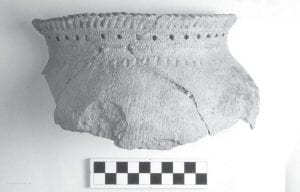The Anishinaabe (Ojibwe) people have been in Cook County for a long time, as evidenced by the Blackduck pottery shard pictured here, which was found in Cook County. According to Grand Portage National Monument Superintendent Tim Cochrane, it is thought to have been made by ancestors of the modern-day Anishinaabe. At a Cook County Historical Society storytelling event in March 2013, Grand Portage State Park Naturalist Victor Aubid explained that the Ojibwe came from the east coast through the St. Lawrence Seaway until they got to Duluth and the Apostle Islands, spreading out from there and moving throughout the region from season to season. Aubid described the cyclical life of the Ojibwe, saying, “you have three seasons to prepare for the fourth.” Each season had its own activities including making maple syrup, gathering berries, and harvesting wild rice. Billy Blackwell, one of the organizers of the event, said the Ojibwe fought the Sioux (Dakota) in Cook County over who was going to own the area’s flint. A bird warned the Ojibwe that the Sioux were coming, and the presence of fog helped the Ojibwe in a battle at Kakabeka Falls, he said. After that, the chief’s daughter, “Lady of the Green Mist,” would appear every spring. Blackwell talked about Great Chief Blackstone from the Quetico, who warned his people not to sign the treaties being offered by the whites. Indians in this region received some of the smallpoxinfested blankets that killed so many Native people years ago. Blackwell said some of Chief Blackstone’s ancestors currently live in Cook County. Tim Cochrane said the Grand Portage Trail has been here for a very long time. “Grand Portage is probably one of the oldest trails in this part of the world,” he said.
This is part of a series about the tales of Cook County history that were shared at the Arrowhead Center for the Arts on March 9, 2013. The event was called “Stories you’ve never heard – and good ones to hear again!”



Leave a Reply